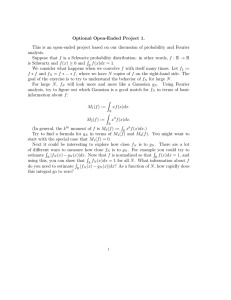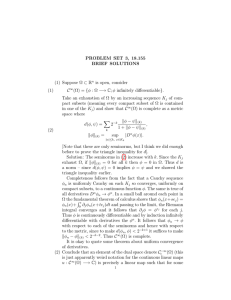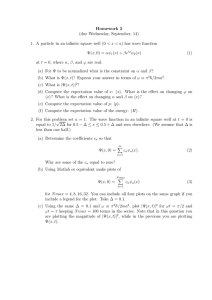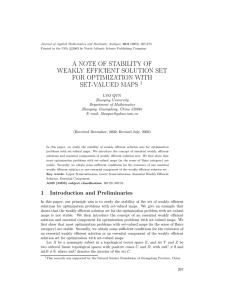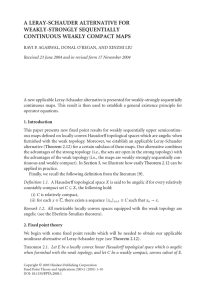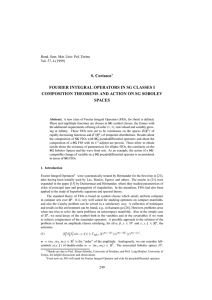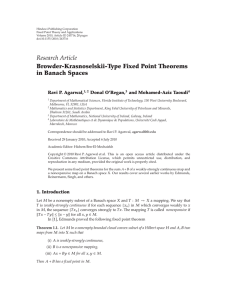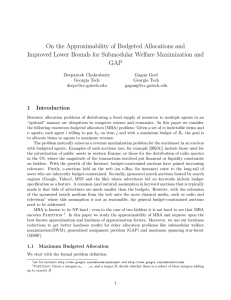LECTURE 9, 18.155, 6 OCTOBER, 2011
advertisement
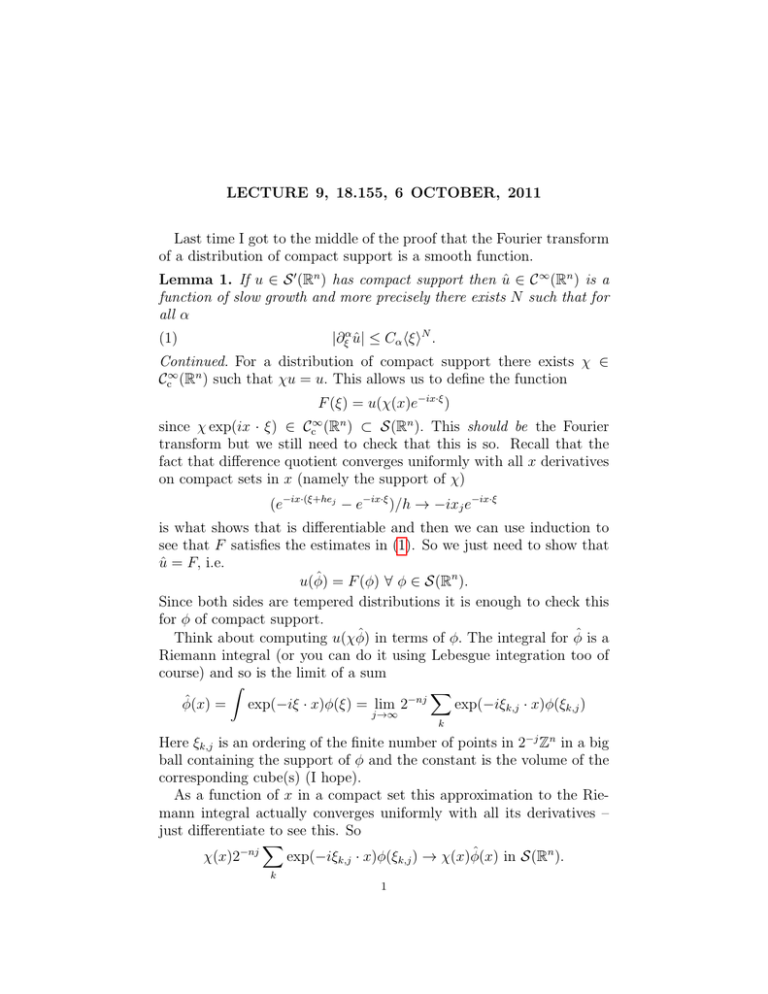
LECTURE 9, 18.155, 6 OCTOBER, 2011
Last time I got to the middle of the proof that the Fourier transform
of a distribution of compact support is a smooth function.
Lemma 1. If u ∈ S 0 (Rn ) has compact support then û ∈ C ∞ (Rn ) is a
function of slow growth and more precisely there exists N such that for
all α
|∂ξα û| ≤ Cα hξiN .
(1)
Continued. For a distribution of compact support there exists χ ∈
Cc∞ (Rn ) such that χu = u. This allows us to define the function
F (ξ) = u(χ(x)e−ix·ξ )
since χ exp(ix · ξ) ∈ Cc∞ (Rn ) ⊂ S(Rn ). This should be the Fourier
transform but we still need to check that this is so. Recall that the
fact that difference quotient converges uniformly with all x derivatives
on compact sets in x (namely the support of χ)
(e−ix·(ξ+hej − e−ix·ξ )/h → −ixj e−ix·ξ
is what shows that is differentiable and then we can use induction to
see that F satisfies the estimates in (1). So we just need to show that
û = F, i.e.
u(φ̂) = F (φ) ∀ φ ∈ S(Rn ).
Since both sides are tempered distributions it is enough to check this
for φ of compact support.
Think about computing u(χφ̂) in terms of φ. The integral for φ̂ is a
Riemann integral (or you can do it using Lebesgue integration too of
course) and so is the limit of a sum
Z
X
φ̂(x) = exp(−iξ · x)φ(ξ) = lim 2−nj
exp(−iξk,j · x)φ(ξk,j )
j→∞
k
Here ξk,j is an ordering of the finite number of points in 2−j Zn in a big
ball containing the support of φ and the constant is the volume of the
corresponding cube(s) (I hope).
As a function of x in a compact set this approximation to the Riemann integral actually converges uniformly with all its derivatives –
just differentiate to see this. So
X
χ(x)2−nj
exp(−iξk,j · x)φ(ξk,j ) → χ(x)φ̂(x) in S(Rn ).
k
1
2
LECTURE 9, 18.155, 6 OCTOBER, 2011
By the continuity of u this implies
X
u(χφ̂) = lim u(χ(x)2−nj
exp(−iξk,j · x)φ(ξk,j )
j→∞
k
→ χ(x)φ̂(x) in S(Rn )
Z
X
=⇒ lim
F (ξkj )φ = F (ξ)φ(ξ)
j→∞
k
again by the properties of Riemann integrals.
So indeed û = F.
I said we would check that the extension of the Fourier transform
(etc) to S 0 (Rn ) was forced by continuity here is the first version. We
can say that a sequence uj ∈ S 0 (Rn ) converges weakly to u ∈ S 0 (Rn )
if uj (φ) → u(φ) in C for all φ ∈ S(Rn ). The limit is certainly unique
and we can use the Fourier transform on S(Rn ) to prove that S(Rn ) ⊂
S 0 (Rn ) is weakly dense.
Lemma 2. If u ∈ S 0 (Rn ) then there exists a sequence uj ∈ S(Rn ) such
that φj → u weakly in S 0 (Rn ).
Proof. We know that if χ ∈ Cc∞ (Rn ) has χ(x) = 1 in |x| < 1 then χk φ →
φ in S(Rn ), where χk (x) = χ( xk ). Now, if u ∈ S 0 (Rn ) then u(χk φ) →
u(φ) for all φ ∈ S(Rn ), which means that χk u(φ) → u(φ) which is the
statement χk u → u weakly. Here, χk u has compact support, since,
for instance taking χ so that χ(x) = 0 in |x| > 2, χ3k χk = χk so
χ3k (χk u) = χk u.
Thus we have shown that the subset of distributions of compact
support, which I will denote Cc−∞ (Rn ) ⊂ S 0 (Rn ), is a weakly dense
subspace.
So, now (by a standard diagonalization argument) we just need to
show that if u ∈ Cc−∞ (Rn ) then we can find a sequence un → u weakly
in S 0 (Rn ) with un ∈ S(Rn ). Fourier transform. By the preceeding
result, û ∈ C ∞ (Rn ) so χk û ∈ Cc∞ (Rn ) ⊂ S(Rn ) where we know that
χk û(φ) → û(φ) ∀ φ ∈ S(Rn )
since for instance χk û → û in L1 or C00 . Anyway, this implies that uk ,
defined by ubk = χk û is a sequence in S(Rn ) which converges weakly to
u.
Another consequence of this is something you already know, namely
the Riesz Representation for L2 . Here we can say it in the form
Lemma 3. If u ∈ S 0 (Rn ) and
|u(φ)| ≤ CkφkL2 ∀ φ ∈ S(Rn )
LECTURE 9, 18.155, 6 OCTOBER, 2011
3
then u ∈ L2 (Rn ).
Proof. If u ∈ S 0 (Rn ) satisfies the estimate (3) then so does χu if χ ∈
Cc∞ (Rn ) since
|χu(φ)| = |u(χφ)| ≤ CkχφkL2 ≤ C 0 kφkL2 .
Then F = χ
cu also satisfies the same estimate since F is bounded with
respect to the L2 norm:|c
χu(φ)| = |u(χφ̂)| ≤ Ckχφ̂kL2 ≤ C 0 kφ̂kL2 ≤ C 00 kφkL2 .
However, from the result above, χ
cu = F is a smooth function and we
can easily check that this is in L2 . Namely χ( kξ )F must be Cauchy in
L2 . So, using the inverse Fourier transform, which we know maps L2
into itself, we conclude that χu ∈ L2 . Then again we can take a limit
of χ( xk )u to see that u ∈ L2 (Rn ).
The abstract proof of the Riesz Representation Theorem in a Hilbert
space is rather neater, but this concrete one is more a guide to other
such constructions – for instance the Schwartz kernel theorem.
So, next to the structure theorem for tempered distributions. This
can be stated in various ways, let’s try a concise one.
Theorem 1 (Schwartz Structure Theorem). Any u ∈ S(Rn ) is of the
the form
(2)
u = hDi2N (hxi2N vN ), vN ∈ C00 (Rn ) ∩ L2 (Rn )
for some N ∈ N.
The notation on the right here is
hDh2 = 1 + |D|2 = 1 +
X
j
Dj2 = 1 −
X
∂j2
j
is a differential operator of order 2 so in (2) there is a differential
operator of order 2N. A somewhat weaker (but essentially equivalent)
statement is that any tempered distribution is a finite sum of products
xα ∂ β vα,β with the vα,β bounded and continuous (or L2 ) and this follows
just by expanding out the right side of (2).
Proof. The main step is a judicious application of the Sobolev embedding theorem and then the Riesz representation theorem.
All we know initially is that u ∈ S 0 (Rn ) and that means that for
some M,
X
|u(φ)| ≤ C
sup |xα Dβ φ| ∀ φ ∈ S(Rn ).
|α|+|β|≤M
4
LECTURE 9, 18.155, 6 OCTOBER, 2011
We start by dividing u by the functon hxi−2N – which we know has
slow growth. This means of course that if v = hxi−2N u satisfies the
corresponding estimate
X
|v(φ)| ≤ C
sup |xα Dβ (hxi−M φ)| ∀ φ ∈ S(Rn ).
|α|+|β|≤M
Applying Leibniz formula to commute all the derivatives through, we
get a big sum on the right but of the form
X
|v(φ)| ≤ C
sup |gβ (x)Dβ φ)| ≤ kφ|C M ∀ φ ∈ S(Rn )
|β|≤M
where if 2N > M then all the gβ are bounded smooth functions the
polynomials being swamped by the decay in hxi−2N . Now, we just have
a C N norm on the right, no polynomials in it at all.
Here is where Sobolev comes in, since that says
|v(φ)| ≤ Ckφ|C M ≤ C 0 kφkH M 0 , M 0 > M + n/2.
Writing out the Sobolev norm explicitly we conclude that
0
|v̂(φ)| = |v(φ̂)| ≤ C 0 kφ̂|H M 0 = C 00 khξiM φkL2 .
Now consider w = hξi−2N v̂ ∈ S 0 (Rn ) where 2N > M 0 , it satisfies
kw(φ)k = |v̂(hξi−2N φ)| ≤ kφkL2
so, by the Riesz representation theorem above, w ∈ L2 (Rn ). If we now
increase N by say n we get v̂ = hξi2N w0 where hξik w0 ∈ L2 (Rn ) for
some k > n/2. This means w0 = v̂N where vN ∈ H k (Rn ) for k > n/2
and hence vN ∈ L2 (Rn ) ∩ C00 (Rn ). So actually we are done since
u = hxi2N hDi2N vN .
Note that we can make vN more regular, and decay more, by increasing N. Let us denote these doubly-indexes spaces by
hxitH s (Rn ) = {u ∈ S 0 (Rn ); u = hxiv, v ∈ H s (Rn )}.
These spaces decrease as s increases by increase as t increases. The
two results this week, Sobolev embedding and Schwartz representation
theorems show that
\
S(Rn ) = hxi−s H s (Rn ),
s
0
n
S (R ) =
[
s
hxi−s H s (Rn ).
LECTURE 9, 18.155, 6 OCTOBER, 2011
5
These show the profound difference between these two spaces. The
Schwartz test functions are a ‘projective limit’ of Banach (even Hilbert)
spaces – the intersection of a countable collection where the norm increases. The tempered distributions are an ‘inductive limit’ of Hilbert
spaces – the union of a countable collection where the norm decreases.
Exercise 1. A topology on S 0 (RSn ) is defined by taking as open sets
those O ⊂ S 0 (Rn ) such that O ∩ s hxi−s H s (Rn ) is open for all s. Show
that this is indeed a topology and that a linear map S 0 (Rn ) −→ C
is continuous if and only if it is given by pairing with an element of
S(Rn ).


